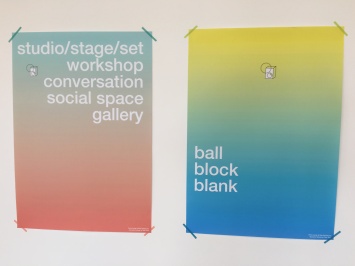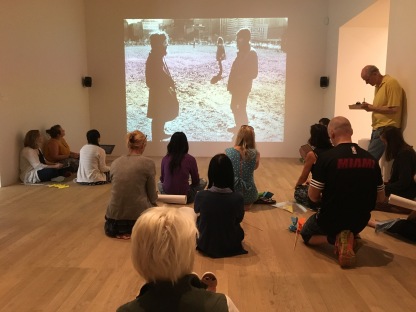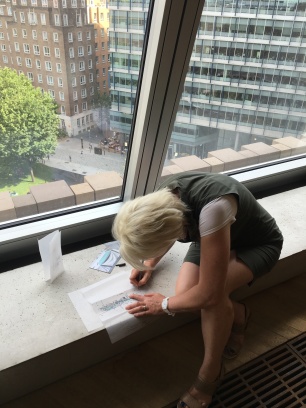Health warning – this week I am using my blog as part of ethnographic research at Tate. This is the fifth summer school I have attended as a participant researcher. The posts represent a first “cut” of notes taken during the day. The posts are intended to stand as a record of activities but also have some preliminary ideas about “what is going on” (the research question). All but one of the participants have voluntarily signed ethics and photo consent forms. The posts are immediately available to participants and they become part of the summer school process. This is “live” method. Because the posts are written rapidly, they are unpolished and may contain typos!
Tate Summer School is being run by practitioners Anna Lucas and Alex Schady who have, we were told, both artist and teacher selves. Both are important to the Summer School. Anna and Alex also both work with moving and still image, and this is the focus for the week’s programme.
The participants, 24 in total, are from primary and secondary schools, colleges, universities and galleries. They work/ed in Russia, Singapore, Spain, Israel, Hong Kong and the UK. Most came to “get inspired” and a few to “get ideas to take back to school.” There are also Tate staff in the school, one is experiencing it as a full participant. And of course me, the researcher who hangs around.
Summer School is being held in the new Tate Exchange room, on the fifth floor of the Switchhouse. It’s a magnificent learning space which allows for different activity zones – eating, chatting, meeting, watching, making. There is ample room for everyone to spread out, to chat in small groups, and work as one big school. The scape of the city of London and Southbank/Southwark are always in sight.

learning zones on left, concepts for the day on right
This was an exercise which showed that the image is incapable of being made into a limited range of words. However it was also an exercise which created a shared experience among the group about the theme of the day (formal images), and brought into the room the kinds of language resources that we would use in the day’s talking, thinking and making.

clay objects made during introductions
Then the introductions. Everyone was also given a small piece of clay and asked to make, at the same time as listening, a small geometric shape. This led into a discussion about the summer school focus on formality – no figures, no narratives, we were told. The words for the day were “Ball, block and blank”.
If there are restrictive rules applied to a learning/making task, this is not necessarily a problem, Anna and Alex said, because that forced us to think more creatively about how to move within restrictions.
We discovered that each day would follow a similar pattern – an introductory “wake and shake” exercise, group work, visiting works in the gallery and responding to them, individual making and a concluding discussion. We would work individually, in small groups and as a whole. Sometimes the activities would be rapid fire, at other times slowed down to create an “art room atmosphere”. There would be lots of making.

Bind Movie Drawing
The images of both of these gallery-based activities are to be photographed and filmed and will be available on Tuesday.
Shared lunch in the Exchange space allowed smaller groups to come together to chat socially, an important part of the summer school experience, but not subject to any pedagogical steerage.

Leaning Tower of Pisa snap: plinth
Alex and Anna haven’t worked together a lot, and their work is very different. But because we saw their images projected side by side, we could see some of the connections and commonalities in the ideas they explored. (This was an exercise like the one with which we had begun the day – finding/seeing connections between images.)
The pattern of making something, making an image of it, and then displaying it was maintained throughout the day. The afternoon involved a protracted period of individual making in response to instructions. I chose to select an image and take at least three photos of it. Other people worked with making collages of images, making holes in images that could be used to look through, covering parts of images with black ink… each person then chose one image and an object to put, in turn, onto a revolving table. Anna used a mounted camera to produce a visual montage of the whole group’s afternoon.

deeply absorbed in making
Art education was said to be valuable because:
- it allowed students to make connections between other subjects, and between important parts of their lives
- it offered all students an alternative way to express themselves. This was particularly important for those young people who otherwise experienced failure at school
- it brought students together and it also brought them together with their communities
- it had “no right or wrong” but relied on students bringing and working through their own ideas
- it was in everything
- the thinking process used was helpful across the curriculum and was of benefit to everyone, regardless of what they wanted to do in the future
- it developed systematic thinking, ideas and making skills at the same time
- it was unpredictable, creative and required ongoing problem solving – the 21st century skill set.
There was discussion about how much art ought to be concerned with vocational ends, and also about the possibilities of resistance to the narrowing of the curriculum and the focus on assessable predetermined outcomes – a theme that is to continue. Some differences between sectors, and countries and schools also began to emerge.
In the spirit of “No mind maps” and “No lists of action points”, the discussion concluded with each person having their meeting doodle-drawing made into a badge. The badge was pinned onto a banner which had the day’s question – what is the value – on it. The banner and badges were evidence that the discussion had occurred, Alex said, but also that its value was in the moment, in the doing and listening.
Pedagogic points:
- establish shared experience and vocabulary before beginning discussion
- use what participants bring as shared resource
- establish learning zones
- offer a limited number of learning activities as a routine (consider the sequencing and pacing)
- offer the same task in multiple ways – practice what is important e.g. finding connections between formal images; make, take and displays
- offer opportunity for critical meta discussion about shared practice









